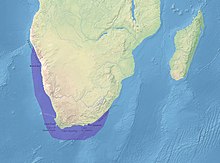| African penguin | |
|---|---|

| |
| At Boulders Beach in Simon's Town, South Africa | |
| Scientific classification | |
| Domain: | Eukaryota |
| Kingdom: | Animalia |
| Phylum: | Chordata |
| Class: | Aves |
| Order: | Sphenisciformes |
| Family: | Spheniscidae |
| Genus: | Spheniscus |
| Species: | S. demersus
|
| Binomial name | |
| Spheniscus demersus | |

| |
| IUCN range (2024)
Extant (resident)
Extant (non-breeding)
Extant (breeding)
Extant & Reintroduced (breeding)
| |

| |
| Distribution of the African penguin | |
| Synonyms | |
|
Diomedea demersa Linnaeus, 1758 | |
The African penguin (Spheniscus demersus), also known as Cape penguin or South African penguin, is a species of penguin confined to southern African waters. Like all penguins, it is flightless, with a streamlined body and wings stiffened and flattened into flippers for a marine habitat. Adults weigh an average of 2.2–3.5 kg (4.9–7.7 lb) and are 60–70 cm (24–28 in) tall. The species has distinctive pink patches of skin above the eyes and a black facial mask. The body's upper parts are black and sharply delineated from the white underparts, which are spotted and marked with a black band.
The African penguin is a pursuit diver and feeds primarily on fish and squid. Once extremely numerous, the African penguin is now the rarest species of penguin classified as critically endangered, with its population declining rapidly due to a combination of several threats. It is a charismatic species and is popular with tourists. Other vernacular names of the species include black-footed penguin and jackass penguin, due to the species' loud, donkey-like noise[3] (although several related species of South American penguins produce the same sound). They can be found along the coast of South Africa and Namibia.
- ^ BirdLife International (2024). "Spheniscus demersus". IUCN Red List of Threatened Species. 2024: e.T22697810A256021744. doi:10.2305/IUCN.UK.2024-2.RLTS.T22697810A256021744.en. Retrieved 28 October 2024.
- ^ "Appendices | CITES". cites.org. Retrieved 2022-01-14.
- ^ Favaro, Livio; Ozella, Laura; Pessani, Daniela; Pavan, Gianni (30 July 2014). "The Vocal Repertoire of the African Penguin (Spheniscus demersus): Structure and Function of Calls". PLOS ONE. 9 (7): e103460. Bibcode:2014PLoSO...9j3460F. doi:10.1371/journal.pone.0103460. PMC 4116197. PMID 25076136.
